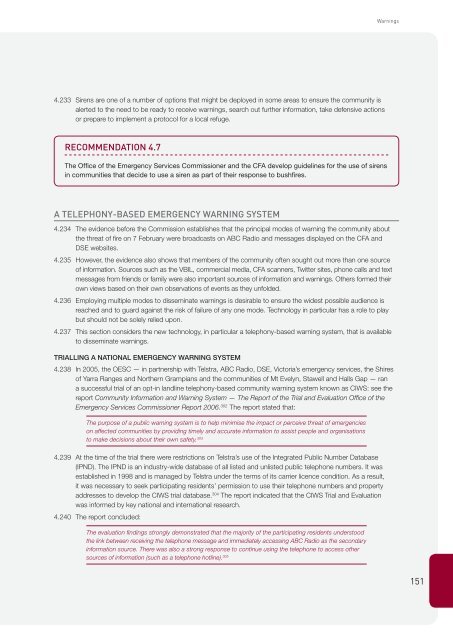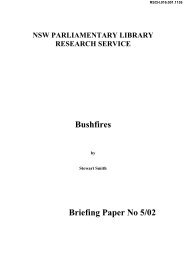Chapter 4 - Warnings - 2009 Victorian Bushfires Royal Commission
Chapter 4 - Warnings - 2009 Victorian Bushfires Royal Commission
Chapter 4 - Warnings - 2009 Victorian Bushfires Royal Commission
Create successful ePaper yourself
Turn your PDF publications into a flip-book with our unique Google optimized e-Paper software.
<strong>Warnings</strong><br />
4.233 Sirens are one of a number of options that might be deployed in some areas to ensure the community is<br />
alerted to the need to be ready to receive warnings, search out further information, take defensive actions<br />
or prepare to implement a protocol for a local refuge.<br />
RECOMMENDATION 4.7<br />
The Office of the Emergency Services <strong>Commission</strong>er and the CFA develop guidelines for the use of sirens<br />
in communities that decide to use a siren as part of their response to bushfires.<br />
A TELEPHONY-BASED EMERGENCY WARNING SYSTEM<br />
4.234 The evidence before the <strong>Commission</strong> establishes that the principal modes of warning the community about<br />
the threat of fire on 7 February were broadcasts on ABC Radio and messages displayed on the CFA and<br />
DSE websites.<br />
4.235 However, the evidence also shows that members of the community often sought out more than one source<br />
of information. Sources such as the VBIL, commercial media, CFA scanners, Twitter sites, phone calls and text<br />
messages from friends or family were also important sources of information and warnings. Others formed their<br />
own views based on their own observations of events as they unfolded.<br />
4.236 Employing multiple modes to disseminate warnings is desirable to ensure the widest possible audience is<br />
reached and to guard against the risk of failure of any one mode. Technology in particular has a role to play<br />
but should not be solely relied upon.<br />
4.237 This section considers the new technology, in particular a telephony-based warning system, that is available<br />
to disseminate warnings.<br />
TRIALlING A nATIONAL EMERGENCY WARNING SYSTEM<br />
4.238 In 2005, the OESC — in partnership with Telstra, ABC Radio, DSE, Victoria’s emergency services, the Shires<br />
of Yarra Ranges and Northern Grampians and the communities of Mt Evelyn, Stawell and Halls Gap — ran<br />
a successful trial of an opt-in landline telephony-based community warning system known as CIWS: see the<br />
report Community Information and Warning System — The Report of the Trial and Evaluation Office of the<br />
Emergency Services <strong>Commission</strong>er Report 2006. 302 The report stated that:<br />
The purpose of a public warning system is to help minimise the impact or perceive threat of emergencies<br />
on affected communities by providing timely and accurate information to assist people and organisations<br />
to make decisions about their own safety. 303<br />
4.239 At the time of the trial there were restrictions on Telstra’s use of the Integrated Public Number Database<br />
(IPND). The IPND is an industry-wide database of all listed and unlisted public telephone numbers. It was<br />
established in 1998 and is managed by Telstra under the terms of its carrier licence condition. As a result,<br />
it was necessary to seek participating residents’ permission to use their telephone numbers and property<br />
addresses to develop the CIWS trial database. 304 The report indicated that the CIWS Trial and Evaluation<br />
was informed by key national and international research.<br />
4.240<br />
The report concluded:<br />
The evaluation findings strongly demonstrated that the majority of the participating residents understood<br />
the link between receiving the telephone message and immediately accessing ABC Radio as the secondary<br />
information source. There was also a strong response to continue using the telephone to access other<br />
sources of information (such as a telephone hotline). 305<br />
151
















